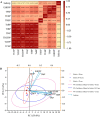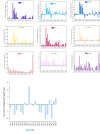Organophosphate Esters in Air and Seawater of the South China Sea: Spatial Distribution, Transport, and Air-Sea Exchange
- PMID: 39473617
- PMCID: PMC11504352
- DOI: 10.1021/envhealth.3c00059
Organophosphate Esters in Air and Seawater of the South China Sea: Spatial Distribution, Transport, and Air-Sea Exchange
Abstract
Organophosphate esters (OPEs) have become one group of chemicals with emerging concern in the marine environment. In this work, we investigated OPEs in the air and seawater of the South China Sea in summer 2019. The concentrations of ∑10OPEs in the atmosphere ranged from 66 to 550 pg/m3, with TCIPP, TNBP, TPhP, and TEP predominating in the air. The total dissolved OPE concentrations (∑10OPEs without TEP) measured in high-volume water samples ranged from 300 to 3600 pg/L, with a mean concentration of 1180 ± 910 pg/L. TEP was measured with liquid-liquid extraction (LLE), and it showed the highest concentration (average 2000 ± 1450 pg/L) among the selected OPEs. Total suspended matter associated OPEs accounted for less than 4.7% of the sum of OPE concentrations in seawater. Fugacity fractions and air-sea exchange fluxes showed that TCEP, TCIPP, TIBP, TEHP, TPhP, and EHDPP were favored to volatilize, TEP dominated the deposition, while TPrP and TNBP varied between volatilization and deposition. Atmospheric particle deposition fluxes ranged from 5 to 71 ng/m2/day with an average of 17 ± 15 ng/m2/day. The input of ∑OPEs to the entire South China Sea via atmospheric particle deposition was estimated to be 22 ± 19 tons/year, while the net air-sea exchange fluxes of OPEs were volatilization from seawater to air with an average of 44 ± 33 tons/year. This work suggests that air-sea exchange and atmospheric particle deposition are significant processes interfering with the transport of OPEs in the marine environment.
© 2023 The Authors. Co-published by Research Center for Eco-Environmental Sciences, Chinese Academy of Sciences, and American Chemical Society.
Conflict of interest statement
The authors declare no competing financial interest.
Figures






Similar articles
-
Occurrence, source, and transfer fluxes of organophosphate esters in the South Pacific and Fildes Peninsula, Antarctic.Sci Total Environ. 2023 Oct 10;894:164263. doi: 10.1016/j.scitotenv.2023.164263. Epub 2023 Jun 12. Sci Total Environ. 2023. PMID: 37315614
-
Organophosphate esters in atmospheric particles and surface seawater in the western South China Sea.Environ Pollut. 2022 Jan 1;292(Pt A):118255. doi: 10.1016/j.envpol.2021.118255. Epub 2021 Sep 29. Environ Pollut. 2022. PMID: 34600061
-
Occurrence and dry deposition of organophosphate esters in atmospheric particles over the northern South China Sea.Chemosphere. 2015 May;127:195-200. doi: 10.1016/j.chemosphere.2015.02.015. Epub 2015 Feb 27. Chemosphere. 2015. PMID: 25732631
-
High-resolution mass spectrometry-based screening and dietary intake assessment of organophosphate esters in foodstuffs from South China.Sci Total Environ. 2023 Dec 20;905:167169. doi: 10.1016/j.scitotenv.2023.167169. Epub 2023 Sep 18. Sci Total Environ. 2023. PMID: 37730029 Review.
-
Organophosphate esters in water and air: A minireview of their sources, occurrence, and air-water exchange.Chemosphere. 2024 May;356:141874. doi: 10.1016/j.chemosphere.2024.141874. Epub 2024 Apr 3. Chemosphere. 2024. PMID: 38575079 Review.
Cited by
-
Inferring atmospheric sources of gaseous organophosphate esters from spatial patterns.Environ Toxicol Chem. 2025 Mar 1;44(3):643-652. doi: 10.1093/etojnl/vgae089. Environ Toxicol Chem. 2025. PMID: 39913418 Free PMC article.
References
-
- Xie Z. Y.; Wang P.; Wang X.; Castro-Jimenez J.; Kallenborn R.; Liao C. Y.; Mi W. Y.; Lohmann R.; Vila-Costa M.; Dachs J. Organophosphate ester pollution in the oceans. Nat. Rev. Earth & Environ. 2022, 3 (5), 309–322. 10.1038/s43017-022-00277-w. - DOI
-
- Blum A.; Behl M.; Birnbaum L. S.; Diamond M. L.; Phillips A.; Singla V.; Sipes N. S.; Stapleton H. M.; Venier M. Organophosphate Ester Flame Retardants: Are They a Regrettable Substitution for Polybrominated Diphenyl Ethers?. Environ. Sci. Technol. Letters 2019, 6 (11), 638–649. 10.1021/acs.estlett.9b00582. - DOI - PMC - PubMed
-
- MEE . List of Chemicals under Priority Control (Second Batch). Ministry of Ecology and Environment of People’s Republic of China. http://www.nhc.gov.cn/jkj/s5898bm/202011/6a7fb860a82d44b581c31459cb5ddde....
LinkOut - more resources
Full Text Sources
